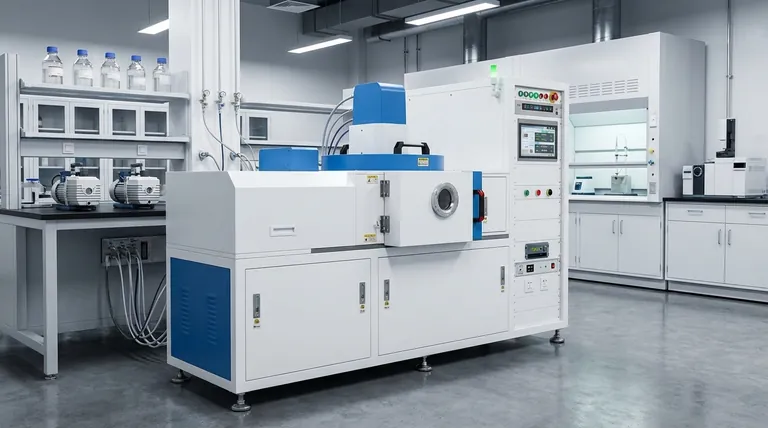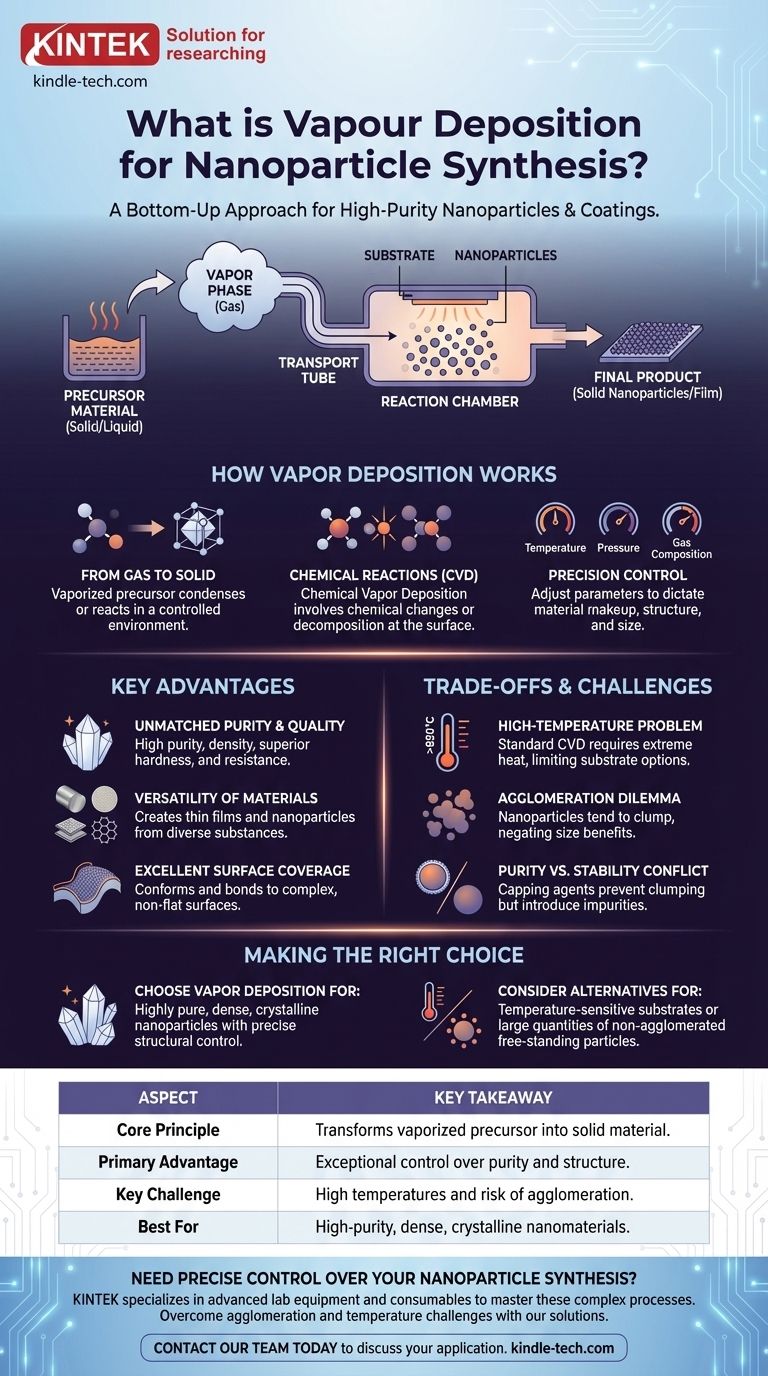In essence, vapor deposition is a family of processes used to synthesize high-purity nanoparticles and coatings by transforming a material from a gas or vapor state into a solid. A precursor material is vaporized, transported to a specific environment, and then allowed to condense or react on a surface, building the desired material atom-by-atom or molecule-by-molecule. This bottom-up approach offers exceptional control over the final product's properties.
The core value of vapor deposition for nanoparticle synthesis lies in its ability to produce materials of extremely high purity and controlled structure. However, this precision comes with significant challenges, most notably high process temperatures and the inherent risk of particle agglomeration.
How Vapor Deposition Works: The Core Principle
Vapor deposition methods are fundamentally about phase transition, moving from a gas to a solid under controlled conditions.
From Gas to Solid
The process begins by converting a solid or liquid precursor material into a gaseous phase, typically through heating or sublimation. This vapor is then transported into a reaction chamber where conditions are precisely managed to cause it to deposit as a solid onto a substrate or form as free-standing particles.
The Role of Chemical Reactions (CVD)
One of the most common methods is Chemical Vapor Deposition (CVD). In CVD, the gaseous precursors don't just condense; they undergo a chemical reaction or thermal decomposition at or near a substrate surface.
This process is defined by three characteristics: a chemical change occurs, all film materials come from an external gas-phase source, and the reactants must be in a gaseous state.
The Power of Precision Control
The primary advantage of vapor deposition is the level of control it offers. By carefully adjusting parameters like temperature, pressure, and gas composition, you can dictate the final material's chemical makeup, crystal structure, grain size, and morphology.
Key Advantages of This Approach
The bottom-up nature of vapor deposition unlocks several key benefits compared to other synthesis methods.
Unmatched Purity and Quality
Because the process starts with purified gaseous precursors in a controlled vacuum environment, it's possible to create materials with exceptional purity and density. The resulting nanoparticles and films often exhibit superior hardness and resistance to damage.
Versatility of Materials
Vapor deposition is not limited to a single class of materials. It can be used to create thin films and nanoparticles from a wide array of substances, including pure metals, alloys, ceramics, and advanced materials like graphene.
Excellent Surface Coverage
For applications involving coatings, the gaseous nature of the precursor allows it to conform and bond to complex, non-flat surfaces, providing excellent "wrap-around" properties that are difficult to achieve with line-of-sight methods.
Understanding the Trade-offs and Challenges
Despite its strengths, vapor deposition is not without significant practical limitations that must be considered.
The High-Temperature Problem
A major drawback of traditional CVD is the extremely high reaction temperature required, often between 850°C and 1100°C. Many substrate materials cannot withstand this heat without degrading, which severely limits its application.
Modern techniques like plasma-assisted or laser-assisted CVD can lower this deposition temperature, but they add complexity and cost to the setup.
The Agglomeration Dilemma
As nanoparticles form from the vapor phase, their high surface energy makes them incredibly prone to agglomerating, or clumping together. Achieving a high yield of individual, free-standing nanoparticles is a significant challenge.
This clumping can negate the benefits of having precisely sized nanoparticles in the first place, as their collective properties will differ from their individual ones.
The Purity vs. Stability Conflict
While some methods like cryomilling produce free-standing particles without additives, preventing agglomeration in other methods often requires introducing capping agents or surfactants.
These agents coat the nanoparticle surface to prevent sticking, but they also introduce impurities. This creates a direct conflict between achieving particle stability and maintaining the high purity that is a key advantage of the vapor deposition technique.
Making the Right Choice for Your Goal
The decision to use vapor deposition hinges on balancing the need for ultimate control and purity against its practical constraints.
- If your primary focus is creating highly pure, dense, and crystalline nanoparticles: Vapor deposition is a superior choice, as its gas-phase synthesis minimizes contamination and allows for precise structural control.
- If your primary focus is depositing on a temperature-sensitive substrate: Standard CVD is likely unsuitable; you must investigate lower-temperature alternatives like plasma-enhanced CVD (PECVD).
- If your primary focus is producing large quantities of free-standing, non-agglomerated particles: Be prepared for significant process development to manage agglomeration, or consider alternative methods that inherently avoid this issue.
Ultimately, selecting the right synthesis method requires a clear understanding of your final application's most critical material properties.

Summary Table:
| Aspect | Key Takeaway |
|---|---|
| Core Principle | Transforms a vaporized precursor into a solid material on a surface or as particles. |
| Primary Advantage | Exceptional control over purity, structure, and properties of the final material. |
| Key Challenge | High process temperatures and significant risk of nanoparticle agglomeration. |
| Best For | Applications requiring high-purity, dense, and crystalline nanomaterials. |
Need precise control over your nanoparticle synthesis?
Vapor deposition techniques are powerful but complex. The experts at KINTEK specialize in providing the advanced lab equipment and consumables needed to master these processes. We help laboratories like yours overcome challenges like agglomeration and temperature control to achieve superior material properties.
Contact our team today to discuss your specific application and find the right solution for your research or production needs.
Visual Guide

Related Products
- RF PECVD System Radio Frequency Plasma-Enhanced Chemical Vapor Deposition RF PECVD
- Chemical Vapor Deposition CVD Equipment System Chamber Slide PECVD Tube Furnace with Liquid Gasifier PECVD Machine
- Customer Made Versatile CVD Tube Furnace Chemical Vapor Deposition Chamber System Equipment
- Vacuum Hot Press Furnace Machine for Lamination and Heating
- 1200℃ Split Tube Furnace with Quartz Tube Laboratory Tubular Furnace
People Also Ask
- What are the advantages of PECVD? Enable Low-Temperature, High-Quality Thin-Film Deposition
- What are the benefits of PECVD? Achieve Superior Low-Temperature Thin Film Deposition
- What is the principle of plasma enhanced chemical vapor deposition? Achieve Low-Temperature Thin Film Deposition
- Why is PECVD environment friendly? Understanding the Eco-Friendly Benefits of Plasma-Enhanced Coating
- How are PECVD and CVD different? A Guide to Choosing the Right Thin-Film Deposition Process



















